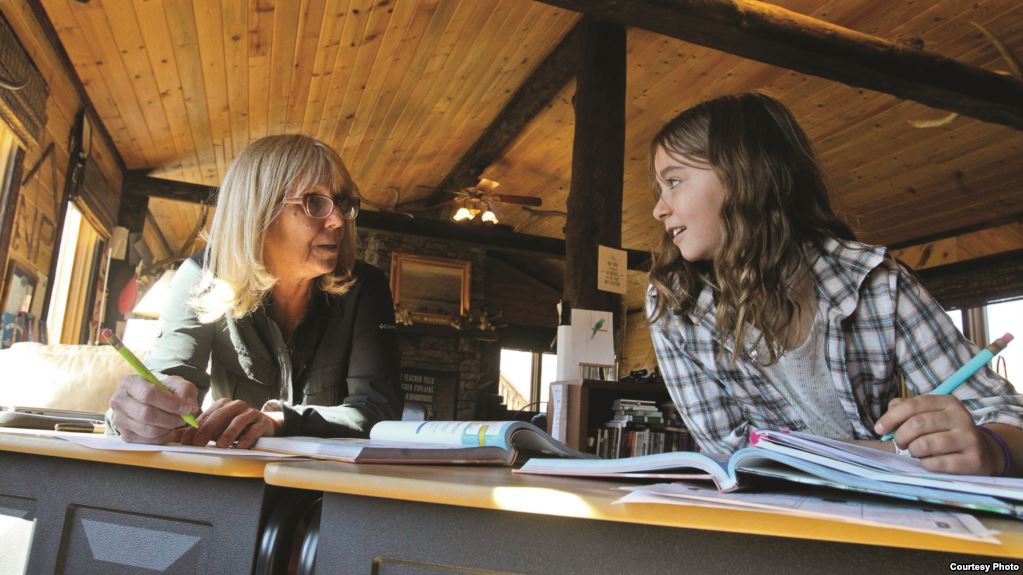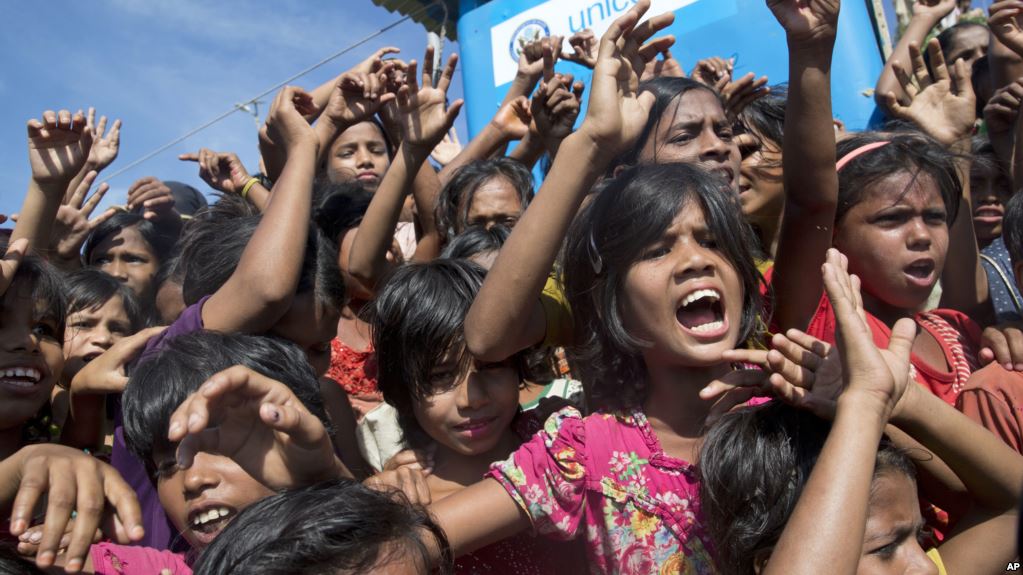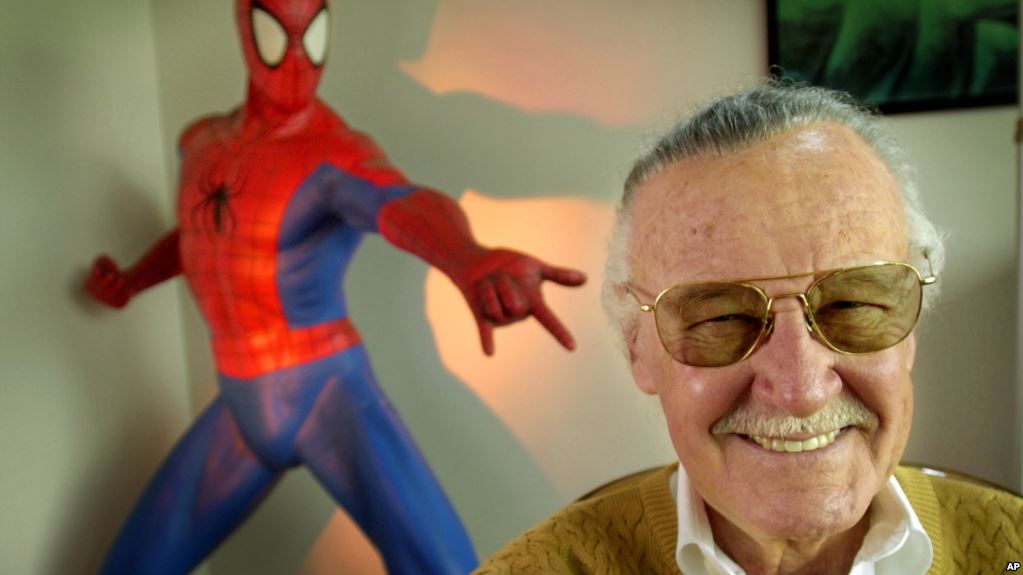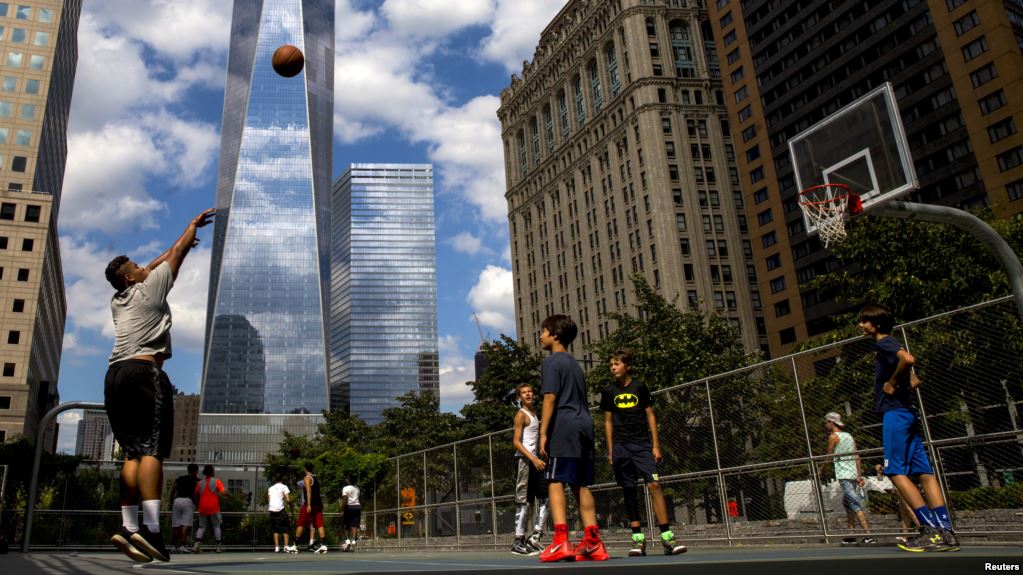뉴스&스피킹(영자신문)
하루 10분이면 영어에 대한 두려움을 극복하고 누구나 유창하게 영어를 구사하실 수 있습니다.
-
 Rural US School Has Just One Student, One Teacher A rural area in the western United States has a very unusual school. The school, in the state of Wyoming, has just one student and only one teacher.
Rural US School Has Just One Student, One Teacher A rural area in the western United States has a very unusual school. The school, in the state of Wyoming, has just one student and only one teacher.
It is called Notch Peak Elementary. The only student is Corinne Gaby. Her teacher is Lisa Geary. Corrine has no brothers or sisters and lives with her parents on a large ranch in a mountainous area.
The school is based on the idea that every child in the U.S. has the right to a public education – no matter where that child lives. But no schools existed in the area where Corinne’s family moved. The closest public school is at least a one-and-a-half hour drive away. And that road is not considered safely passable during the winter.
Her parents also decided that teaching her themselves at home was not realistic. So when Corinne was old enough to start kindergarten, local education officials decided to create Notch Peak Elementary just for her.
A new, separate school was not built. Instead, a classroom area was created on the second floor of a horse barn. Large windows keep the room bright, and a wood stove provides heat.
The teacher
Several teachers were considered for this unusual teaching situation. The first lasted a year. The next left after two.
Then came Lisa Geary. In 2016 Geary was teaching at a small elementary school in the neighboring state of Colorado. She was excited to hear about the new position and in time was hired.
The other teachers had lived in the horse barn. But for Geary, the school district brought a movable home nearby for her to live in. Still, she says her first year was “harder than expected.” She faced lonely surroundings and severe weather.
In an interview, Geary told VOA her relationship with Corinne also got off to a rough start.
“It wasn’t easy in the beginning… [Corinne was] strong-headed, and it was tough.”
Geary said she became discouraged with their lack of progress. At first, she said it seemed like Corinne did not want to be taught.
“We really, really struggled that first year, so it wasn’t fun for me as a teacher who is waiting for her cup to be filled up.”
Corinne agrees that the start of teaching was difficult.
“No, we didn’t have a relationship right off. It was hard to start.”
But over time, Corinne said Geary’s teaching methods changed her mind about the unusual one-on-one learning situation.
“Now in fifth grade and fourth grade, Ms. Geary and I have seen lots of changes in ourselves.”
Corinne says Geary’s teaching has taught her far more than just what happens in the classroom. “She’s my everything teacher.” Corinne adds: “I don’t see why any kid would not want any other teacher that’s just like her.”
Geary adds that in every teaching situation, the relationship between teacher and student is very important. She says that her relationship with Corinne is now so close, the two are like family.
“It really is a really good fit. We know so much about each other, we can finish each other’s sentences sometimes.”
Corinne agrees that the two have a much deeper connection than most students and teachers. She describes Geary as the “greatest teacher in the galaxy.”
“Well, she gives me chances and she really believes in me.”
The two also spend a lot of time together outside the classroom. Sometimes Corinne even gets to sleep over at her teacher’s house, and they both love taking care of the animals on the ranch.
The curriculum
The day usually starts with English-related studies, followed by math before lunch. Additional studies include science, social studies, art and physical education.
Geary says the one-on-one relationship provides the chance for Corinne to learn with a greater “depth of knowledge.”
“We go to school from eight to three, and I’m often saying, I wish we had more time,” she said. However, Geary says she has learned to give Corinne some breaks.
“When I started teaching Corinne, I was one-on-one with her all the time, and I’m in her face, all the time.”
She says she had to learn to pull back a little from the teaching to “give Corinne time to regroup.”
The current situation will likely not continue when Corinne finishes the sixth grade. Geary would have to receive additional training and certifications. She says she sometimes gets sad thinking about this unusual relationship ending.
But in the end, she says she just wants to do what is best for Corinne. She believes it will be good for her to get “a new perspective” in high school and a different teaching environment.
But when Geary does leave Notch Peak, no one expects a permanent goodbye. “I will always be connected to Corinne,” she says. “Even after I leave the 6th grade, she will always be a part of my life. I’ll always be connected.”
I’m Bryan Lynn.View -
 Misinformation or Disinformation The website Dictionary.com has chosen the term ‘misinformation’ as its word of the year. The announcement comes less than two weeks after Oxford Dictionaries chose ‘toxic’ as its word of the year.
Misinformation or Disinformation The website Dictionary.com has chosen the term ‘misinformation’ as its word of the year. The announcement comes less than two weeks after Oxford Dictionaries chose ‘toxic’ as its word of the year.
Many people mix up the meaning of misinformation with the word disinformation. They sometimes use one term in place of the other.
Dictionary.com defines misinformation as “false information that is spread, regardless of whether there is intent to mislead.” And it describes disinformation as “deliberately misleading or biased information; manipulated narrative or facts; propaganda.”
So what's the difference?
Officials at Dictionary.com say it comes down to what the writer or speaker actually means. They say that “when people spread misinformation, they often believe the information they are sharing.” But disinformation is often shared with the goal of misleading others. For example, if people share information that they know to be false in a story or a picture, that is disinformation.
Jane Solomon is a language expert with Dictionary.com. She told VOA that the choice of misinformation, instead of disinformation, was done for a reason. She said, “disinformation is a word that looks outside of ourselves. You can point a finger at someone who is spreading this disinformation.”
As for misinformation, “there is a quality of looking inward and it helps us evaluate our own behavior” to fight against the spread of misinformation.
The word misinformation has been used since the late 1500s. But Solomon said the word was chosen this year because it also “ties to a lot of events that are happening in 2018.”
In Myanmar, misinformation, like hate speech and propaganda, fueled violence against Rohingya Muslims. And there were riots in Sri Lanka after stories that proved false set the country's Buddhist majority against Muslims.
The disappearance and reported killing of Saudi writer Jamal Khashoggi fueled misinformation about him and his fiancée. And stories about Brazil’s recent presidential election were filled with misinformation, everything from incorrect voting times to false campaign promises.
Facebook and other social media websites have published misinformation, including images of police arresting immigrants and long lines at voting stations in the United States. They also posted incorrect voting hours and false voting requirements before the November 6 elections.
Liz McMillan is head of Dictionary.com. She noted that the online publisher has chosen words like identity in 2015, xenophobia in 2016, and complicit in 2017.
She said, “By arming our users with these words and enabling them to identify misinformation when it is encountered gives us a fighting chance against its influence.”
I'm Dorothy Gundy.View -
 NASA: Private Companies to Make Next Moon Landing The U.S. National Aeronautics and Space Administration, or NASA, has announced that private companies will make America’s next moon landing.
NASA: Private Companies to Make Next Moon Landing The U.S. National Aeronautics and Space Administration, or NASA, has announced that private companies will make America’s next moon landing.
NASA Administrator Jim Bridenstine said Thursday that nine American companies will compete to carry experiments to the surface of the moon.
“(The) announcement marks tangible progress in America’s return to the Moon’s surface to stay,” Bridenstine said.
The space agency said in a statement the goal is to bring many science and technology experiments to the moon as soon as possible. The first such flight could come as early as next year.
In 2019, NASA and people across the United States will mark the 50th anniversary of the first manned landing on the moon. The last time humans visited the moon was in 1972, during NASA’s Apollo 17 mission.
NASA officials say the goal of the planned spaceflight is to transport equipment for performing experiments and collecting information about the moon. Some of the companies are expected to develop small launch vehicles or robotic rovers to explore its surface.
The research is meant to help get astronauts back to the moon more quickly and keep them safer once they arrive.
Thomas Zurbuchen is head of NASA’s science mission directorate, which leads the new flight efforts. “We’re going at high speed,” he said.
The space agency says it will award a total of $2.6 billion to private businesses for the moon effort over the next 10 years. Bridenstine said that NASA wants a lot of companies involved to strengthen competition. He also said he expects to have people regularly working on the moon within 10 years.
The new partnership is modeled after another NASA program that uses private companies to transport supplies to the International Space Station, or ISS. SpaceX and Northrop Grumman have made ISS shipments since 2012. SpaceX and Boeing are planning to start transporting astronauts to the space station sometime next year.
NASA has said it expects work on a new space station laboratory to start as soon as 2022. The new space station would orbit the moon. But it is also expected to serve as a launching point for missions to other parts of the solar system, including the planet Mars.
The announcement on future moon flights came just three days after NASA successfully landed its InSight spacecraft on Mars. The InSight lander was built by Lockheed Martin, a private U.S. company. The lander is designed to explore under the surface, studying the geology of the planet and seeking signs of Martian earthquakes.
I’m Bryan Lynn.View -
 Love for Stan Lee on Social Media and More This is What’s Trending Today.
Love for Stan Lee on Social Media and More This is What’s Trending Today.
Messages in honor of Stan Lee are pouring in on social media and other online sites.
Lee is the creator of famous comic book characters, including Spider-Man, the Hulk, Black Panther and others. He died Monday in Los Angeles, California. He was 95 years old.
Marvel Entertainment and its parent company, Walt Disney, posted a video about the late writer, editor and publisher on their websites.
Disney chairman and chief Bob Iger said Lee is “a super hero in his own right to Marvel fans around the world.” He compared Lee to his comic book characters with “the power to inspire, to entertain, and to connect.”
Lee was born Stanley Martin Leiber in New York City. He began writing for comic books at 19. He wrote under the name Stan Lee.
He explained that he used a false name because he wanted to write a serious and great piece of literature someday. He did not want his link with comic books to be known when that happened.
But it never did happen. As the pride in his work grew, he decided to legally change his name to Stan Lee.
Lee’s characters often had super powers, but they also had weaknesses and moral failings. They got up and went to work every morning. They were humans, not gods. They lived in New York City and others parts of real America. They not only struggled to save the world, but also to pay their bills, make friends, and hold jobs.
This made Marvel comic book heroes stand apart from its competitor DC, the company that produced the seemingly perfect heroes like Superman and Wonder Woman.
In a piece for Marvel in 1969, Lee discussed the importance of creating these balanced characters. “…Nobody is all good, or all bad," he wrote.
Like Tony Stark, also known as Iron Man. He is a deeply gifted inventor with serious mental health issues; or, Peter Parker, a sensitive, brainy high-school student who has no idea how to deal with the frightening abilities he gets from the bite of a radioactive spider.
Even Steve Rogers, whose Captain America was the most Superman-like of the Marvel group, had problems. Rejected as a candidate for the armed forces, he volunteers to take a "supersoldier" substance to make him a super-fighting machine.
Actor Chris Evans has played that character in several Hollywood films. He posted a tribute to Captain America’s creator on Twitter Monday.
“There will never be another Stan Lee,” he wrote.
Actor, writer and funny man Seth Rogen never played one of Lee’s characters but he remembered him with thanks in a tweet. “Thank you Stan Lee for making people who feel different realize they are special,” he wrote.
Actor Zoe Saldana played Gamora in the “Guardians of the Galaxy” and “Avengers” film series. “Today we lost one of the greats,” she wrote on Twitter Sunday, calling Stan Lee “superhero to us all.”
And that’s What’s Trending Today.
I’m Pete Musto.View -
 New Exercise Guidelines: Start Young, Sit Less From VOA Learning English, this is the Health & Lifestyle report.
New Exercise Guidelines: Start Young, Sit Less From VOA Learning English, this is the Health & Lifestyle report.
Most of us know that physical activity leads to better health. That is nothing new.
But for the first time in 10 years, the United States government has changed its guidance on how much exercise people need to stay healthy and when they should start.
Brett Giroir is Assistant Secretary for Health at the U.S. Department of Health and Human Services. In a video, he spoke with the Associated Press about the new guidelines.
Dr. Giroir says he is excited about the new guidelines. He adds that getting or attaining the health benefits from exercise may be easier than earlier thought.
“I’m very excited about the guidelines because what we’ve found out is that it’s actually easier to attain the health benefits than we thought before. And the health benefits are so much greater.”
That is good news for people in the U.S. who may need to lose weight.
The U.S. Centers for Disease Control and Prevention reports that in 2016 about 93 million adults nationwide were overweight or considered obese. Its website notes that obesity rates for both adults and children have been rising since 1999.
For children and teens
The new federal guidance states that children as young as 3-years-old need to be physically active. Earlier guidelines used to begin at age 6.
Dr. Girior says that the most important time for children to begin exercising is between the ages of 3 and 5. He notes that boys and girls in this age group need at least three hours of activity every day.
“That was not present in our previous guidelines. But essentially, those recommendations are that children in the 3- to 5-year-old age group really require about three hours of active activities per day. That could be light activities, moderate activities, or even vigorous activities. This is the kind of play that children normally engage in.”
Doctors say it is important to start young. They add that from birth to age 5, a child’s brain develops more than at any other time in life. These developments have a lasting effect on a child’s ability to learn and to succeed in school and in life.
Also, Giroir says that children who start exercising at a young age are more likely to establish healthy behaviors they will continue into adulthood.
Dr. Giroir does not suggest putting your 5-year-old on a “treadmill” or other exercise equipment. He said, simply giving a child the time and space to play actively as they normally would is enough.
The new guidelines say that children ages 6 through 17 get at least one hour of moderate to vigorous activity a day. Most of this activity should be aerobic exercise, such as biking, swimming or running. Aerobic activity can strengthen the heart and lungs by making them work hard for several minutes or more.
Exercise should also include muscle- and bone-strengthening activities, such as climbing trees or playground equipment and playing sports. Experts suggest that children get this kind of exercise at least three times a week.
For adults
For adults, the suggested length of time for exercise remains the same.
“So for adults, the guidelines recommend 150 minutes per week of moderate to vigorous physical activity. That could be brisk walking; it could mowing the lawn; it could be gardening; it could be dancing … any kind of activity that gets your heart rate up and gets you exercising moderately.”
The federal government has changed its guidance for the amount of aerobic exercise adults should have.
Earlier guidelines stated that aerobic activity is only effective if it lasts for at least 10 minutes.
Experts now say that even short amounts of aerobics can help. It can provide short-term health benefits, such as lowering blood pressure, reducing anxiety and improving sleep. They also think adults need at least two days of muscle-strengthening exercise like pushups or lifting weights.
For adults over 65
The advice for older adults remains mostly unchanged from earlier federal guidelines.
However, those over age 65 should include activities that help aid balance and flexibility. Better balance means fewer falls and less chance of injury.
Sitting too much is still very bad
The new guidelines have changed nothing about the dangers of sitting too much. It is especially harmful and can even undo the benefits of exercise you may have gained.
And that’s the Health & Lifestyle report. I’m Anna Matteo.View

